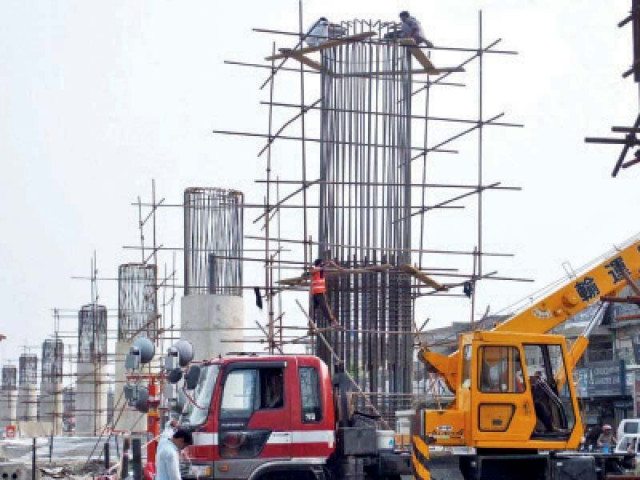Govt plans Rs800b PSDP
Planning ministry seeks to reduce number of ongoing schemes by up to 90%

The Ministry of Finance on Saturday agreed, in principle, to allocate Rs800 billion for the Public Sector Development Programme (PSDP) in the next fiscal year, as the Ministry of Planning seeks to cut the number of ongoing schemes by up to 90% due to the fast-shrinking fiscal space.
The decision to increase development spending in fiscal year 2022-23 from an earlier indicated Rs500 billion to Rs800 billion was taken during a meeting between Finance Minister Dr Miftah Ismail and Planning Minister Ahsan Iqbal.
The government may allocate Rs800 billion for the PSDP in the next fiscal year but final decision would be made after holding talks with the International Monetary Fund (IMF), said Ismail.
The Rs800 billion budget will include Rs100 billion in foreign financing for the schemes.
There is a possibility that the government will try to seek another Rs300 billion in funding under the public-private partnership model to show the total outlay for the next fiscal year at Rs1.1 trillion.
It has also been decided to set up Pakistan Infrastructure Company to directly handle all investments of the federal government in provinces and special areas instead of giving the money to the non-federal executing agencies.
The current PSDP comprises 1,164 projects that require Rs6.3 trillion for completion, leaving no room for financing any new small or big project.
On May 9, the finance ministry informed the planning ministry about the proposed Rs500 billion PSDP for the next fiscal year, which caused unease in the ministry. The proposed Rs500 billion budget was equal to the reduced size of the PSDP for the current fiscal year.
Initially, the previous Pakistan Tehreek-e-Insaf (PTI) government secured Rs900 billion for the PSDP for the current fiscal year, which it later reduced to Rs600 billion.
Last week, the finance ministry further cut the ongoing fiscal year’s PSDP to just Rs500 billion, as the country was heading fast on a path that could take it economically down. So far, Rs383 billion has been spent out of the Rs500 billion budget.
For the next fiscal year, various ministries and organisations have proposed 1,463 projects for financing and sought Rs1.94 trillion from the government. But the demand appeared to be not only unrealistic, but was contrary to Pakistan’s economic conditions that require fiscal discipline and avoiding unnecessary expenditures.
The planning ministry is itself responsible for the mess created around the country’s development portfolio and is still holding meetings to approve new development schemes.
Sources said that the planning ministry informed the Prime Minister’s Office that the PSDP had been used in the past as a financing window for small, regional and local-level schemes.
For instance, in the current fiscal year, there are 225 small schemes with total cost of Rs221 billion. Similarly, there are 326 projects of provincial nature having total value of Rs1.1 trillion that is funded by the federal government.
Successive federal governments have been funding the provincial projects under political expediency, which has further deteriorated the federal government’s fiscal space.
The provincial governments get 57.5% of the federal fiscal resources under the National Finance Commission and also get funding from the Centre for projects of provincial nature.
Sources said that various options had been given to the Prime Minister’s Office in order to ensure prudent spending on development projects in the next fiscal year.
The planning ministry’s preferred choice is that for the next fiscal year, the PSDP funds may only be allocated to the mega projects of national importance.
The number of PSDP projects, which would be 1,000 by June 30, should be cut to just 101, covering projects of national significance only, according to the planning ministry’s recommendation.
This suggests a reduction of 90% in the number of projects in a bid to focus only on mega schemes like the Diamer Bhasha Dam.
The second option is that the government may reduce the number of schemes to around 400 by excluding all provincial schemes and those where the spending is less than 10%.
The third option is that the government can still fund over 520 projects but needs to increase funding and exclude the small schemes being approved by the Departmental Development Working Party.
Due to the scarcity of resources, it is proposed that the provincial government should take control of their 326 schemes and complete them with their own money.
It has also been suggested that the special area development packages including erstwhile Fata, Gilgit-Baltistan and AJK should be approved on a case-to-case basis.
Similarly, in cases where foreign funding is not available or delayed, all such schemes should be dropped from the PSDP.
The planning ministry also wants that all block allocations, like the parliamentarians’ schemes, should be avoided. However, despite such a critical fiscal position, the sources said, the Prime Minister’s Office has asked the planning ministry to relax a condition of submission of PC-I documents for the new schemes by March 31 every year.
The condition had been approved by the National Economic Council, headed by the prime minister.
Published in The Express Tribune, May 15th, 2022.
Like Business on Facebook, follow @TribuneBiz on Twitter to stay informed and join in the conversation.



















COMMENTS
Comments are moderated and generally will be posted if they are on-topic and not abusive.
For more information, please see our Comments FAQ